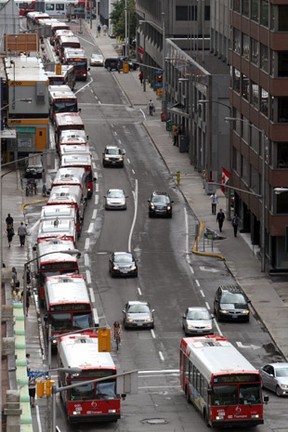Quote:
Originally Posted by Nouvellecosse

The only part I don't agree with is that the point of rapid transit investment is to make transit journeys faster. There are plenty of cases when rapid transit systems are upgraded purely for increased capacity. For instance, cities like Paris and Madrid renovated their busiest metro lines to extend the platforms for purely capacity reasons which is an expensive and disruptive project for an underground system. And there are also examples of new city-centre tunnels like the one planned for Munich S-Bahn that are purely to relieve congestion of the current one.
And closer to home, both Montreal and Toronto were forced into building their first RT routes due to insufficient capacity. Buses and streetcars were too short to hold all the riders, and being stuck in congestion meant there was low throughput. Taking transit out of mixed traffic was necessary to create capacity since it allowed the vehicles to be longer and for them to complete more journeys in the same time frame thus moving more people with the reduction of individual journey duration being an incidental side benefit. Since increases in capacity often have this side benefit people tend to draw the association.
In Ottawa's case a BRT with dedicated, grade separated busways is already a form of rapid transit (in terms of speed) so there's no reason to expect rail to offer a speed increase. It's really more similar to a platform length increase in that respect. But I agree with the criticism that the transfers should have been streamlined in a way to reduce speed loss.
|
Transfers aren't functionally any different than at major TTC hubs. They are alright.
Also the claim that no time is saved at all is dubious. It's based on looking at only the one-seat rides. But this was not service offered throughout the day. It was mostly peak service. And that service was both expensive to run and the very cause of the congestion in the core. Imagine thinking this didn't cause delays:

Overall, post Stage 2, something like 80% of the population will be within 5 km of a station. This means that 80% of the population is within a maximum of an 18 min bus ride to an LRT station. That's very decent coverage. So even with the transfer, most downtown bound riders should net out a few minutes compared to the Transitway days. And they should save a lot more relative to peak time bus congestion which easily added 10-20 mins to any journey most weekdays.
Also, the previous system did real crosstown journeys rather poorly. Was a mix of Transitway and less frequent crosstown routes. They sort of did the job but were definitely going to struggle in a growing city with more crosstown demand. The LRT should do better on this.
Overall, having grown up in Toronto and having experienced OC Transpo in 2012 and today, I think Ottawa residents are whiners. And mostly because they only think of transit in terms of commuting to the core. The rail network being built has plenty of flaws. But it is giving them the basic network needed for a much larger city. The fantasy that they could move a city of 2M exclusively with buses was always ridiculous and was basically only appealing to public servants taking transit from the suburbs to work. I expect the complaints will smooth out after Stage 2 opens and people spend a lot less time on buses.